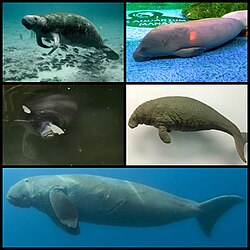
Back خيلانيات Arabic خيلانيات ARZ Sirenia AST Pogdoldunol (Sirenia) AVK Sirenlər Azerbaijani دنیز اینکلری AZB Сірэны (біялогія) Byelorussian Сырэны BE-X-OLD Сирени Bulgarian Sirenia Breton
| Sirenia Temporal range: Early Eocene – Holocene,
| |
|---|---|

| |
| Clockwise from upper left: West Indian manatee, African manatee, Steller's sea cow, dugong, Amazonian manatee | |
| Scientific classification | |
| Domain: | Eukaryota |
| Kingdom: | Animalia |
| Phylum: | Chordata |
| Class: | Mammalia |
| Clade: | Paenungulatomorpha |
| Grandorder: | Paenungulata |
| Mirorder: | Tethytheria |
| Order: | Sirenia Illiger, 1811 |
| Families | |

| |
| West Indian in green, Amazonian in red, African in orange, dugong in blue, Steller's sea cow circled (yellow) | |
| Synonyms[1] | |
| |
The Sirenia (/saɪˈriːni.ə/), commonly referred to as sea cows or sirenians, are an order of fully aquatic, herbivorous mammals that inhabit swamps, rivers, estuaries, marine wetlands, and coastal marine waters. The extant Sirenia comprise two distinct families: Dugongidae (the dugong and the now extinct Steller's sea cow) and Trichechidae (manatees, namely the Amazonian manatee, West Indian manatee, and West African manatee) with a total of four species.[2] The Protosirenidae (Eocene sirenians) and Prorastomidae (terrestrial sirenians) families are extinct. Sirenians are classified in the clade Paenungulata, alongside the elephants and the hyraxes, and evolved in the Eocene 50 million years ago (mya). The Dugongidae diverged from the Trichechidae in the late Eocene or early Oligocene (30–35 mya).[3][4]
Sirenians grow to between 2.5 and 4 metres (8.2 and 13.1 feet) in length and 1,500 kilograms (3,300 pounds) in weight. The recently extinct Steller's sea cow was the largest known sirenian to have lived, reaching lengths of 10 metres (33 feet) and weights of 5 to 10 tonnes (5.5 to 11.0 short tons).[2]
Sirenians have a large, fusiform body which reduces drag through the water and heavy bones that act as ballast to counteract the buoyancy of their blubber. They have a thin layer of blubber and consequently are sensitive to temperature fluctuations, which cause migrations when water temperatures dip too low. Sirenians are slow-moving, typically coasting at 8 kilometres per hour (5.0 miles per hour), but they can reach 24 kilometres per hour (15 miles per hour) in short bursts. They use their strong lips to pull out seagrasses, consuming 10–15% of their body weight per day.
While breathing, sirenians hold just their nostrils above the surface, sometimes standing on their tails to do so. They typically inhabit warm, shallow, coastal waters, or rivers. They are mainly herbivorous, but have been known to consume animals such as birds and jellyfish. Males typically mate with more than one female and may gather in leks to mate. Sirenians are K-selected, displaying parental care.

The meat, oil, bones, and skins are commercially valuable. Mortality is often caused by direct hunting by humans or other human-induced causes, such as habitat destruction, entanglement in fishing gear, and watercraft collisions. Steller's sea cow was driven to extinction due to overhunting in 1768.
- ^ Shoshani 2005.
- ^ a b Walker, Matt. "The giant cow that swam the ocean". BBC. Retrieved 2020-10-29.
- ^ Domning, Daryl P. (1982). "Evolution of Manatees: A Speculative History". Journal of Paleontology. 56 (3): 599–619. ISSN 0022-3360. JSTOR 1304394.
- ^ de Souza, Érica Martinha Silva; Freitas, Lucas; da Silva Ramos, Elisa Karen; Selleghin-Veiga, Giovanna; Rachid-Ribeiro, Michelle Carneiro; Silva, Felipe André; Marmontel, Miriam; dos Santos, Fabrício Rodrigues; Laudisoit, Anne; Verheyen, Erik; Domning, Daryl P. (2021-02-11). "The evolutionary history of manatees told by their mitogenomes". Scientific Reports. 11 (1): 3564. Bibcode:2021NatSR..11.3564D. doi:10.1038/s41598-021-82390-2. ISSN 2045-2322. PMC 7878490. PMID 33574363.